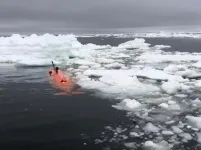(Press-News.org) For the first time, researchers have been able to obtain data from underneath Thwaites Glacier, also known as the "Doomsday Glacier". They find that the supply of warm water to the glacier is larger than previously thought, triggering concerns of faster melting and accelerating ice flow.
With the help of the uncrewed submarine Ran that made its way under Thwaites glacier front, the researchers have made a number of new discoveries. Professor Karen Heywood of the University of East Anglia commented:
"This was Ran's first venture to polar regions and her exploration of the waters under the ice shelf was much more successful than we had dared to hope. We plan to build on these exciting findings with further missions under the ice next year."
The submersible has, among other things, measured the strength, temperature, salinity and oxygen content of the ocean currents that go under the glacier.
Global sea level is affected by how much ice there is on land, and the biggest uncertainty in the forecasts is the future evolution of the West Antarctic Ice Sheet, says Anna Wåhlin, professor of oceanography at the University of Gothenburg and lead author of the new study now published in Science Advances.
Impacts global sea level
The ice sheet in West Antarctica accounts for about ten percent of the current rate of sea level rise; but also the ice in West Antarctica holds the most potential for increasing that rate because the fastest changes worldwide are taking place in the Thwaites Glacier. Due to its location and shape, Thwaites is particularly sensitive to warm and salty ocean currents that are finding their way underneath it.
This process can lead to an accelerated melting taking place at the bottom of the glacier and inland movement of the so-called grounding zone, the area where the ice transitions from resting on the seabed to floating in the ocean.
Due to its inaccessible location, far from research stations, in an area that is usually blocked by thick sea ice and many icebergs, there has been a great shortage of in situ measurements from this area. This means that there are big knowledge gaps for the ice-ocean boundary processes in this region.
First measurements performed
In the study, the researchers present the results from the submersible that measured strength, temperature, salinity and oxygen content of the ocean currents that go under the glacier.
"These were the first measurements ever performed beneath Thwaites glacier", says Anna Wåhlin.
The results have been used to map the ocean currents underneath the floating part of the glacier. The researchers discovered that there is a deep connection to the east through which deep water flows from Pine Island Bay, a connection that was previously thought to be blocked by an underwater ridge.
The research group has also measured the heat transport in one of the three channels that lead warm water towards Thwaites Glacier from the north. "The channels for warm water to access and attack Thwaites weren't known to us before the research. Using sonars on the ship, nested with very high-resolution ocean mapping from Ran, we were able to find that there are distinct paths that water takes in and out of the ice shelf cavity, influenced by the geometry of the ocean floor" says Dr Alastair Graham, University of Southern Florida.
The value measured there, 0.8 TW, corresponds to a net melting of 75 km3 of ice per year, which is almost as large as the total basal melt in the entire ice shelf. Although the amount of ice that melts as a result of the hot water is not much compared to other global freshwater sources, the heat transport has a large effect locally and may indicate that the glacier is not stable over time.
Not sustainable over time
The researchers also noted that large amounts of meltwater flowed north away from the front of the glacier.
Variations in salinity, temperature and oxygen content indicate that the area under the glacier is a previously unknown active area where different water masses meet and mix with each other, which is important for understanding the melting processes at the base of the ice.
The observations show warm water approaching from all sides on pinning points, critical locations where the ice is connected to the seabed and give stability to the ice shelf. Melting around these pinning points may lead to instability and retreat of the ice shelf and, subsequently, the upstream glacier flowing off the land. Dr Rob Larter of the British Antarctic Survey commented:
"This work highlights that how and where warm water impacts Thwaites Glacier is influenced by the shape of the sea floor and the ice-shelf base as well as the properties of the water itself. The successful integration of new sea-floor survey data and observations of water properties from the Ran missions shows the benefits of the multidisciplinary ethos within the International Thwaites Glacier Collaboration."
"The good news is that we are now, for the first time, collecting data that is necessary to model the dynamics of Thwaite's glacier. This data will help us better calculate ice melting in the future. With the help of new technology, we can improve the models and reduce the great uncertainty that now prevails around global sea level variations." says Anna Wåhlin.
INFORMATION:
Contact details:
Anna Wåhlin,
University of Gothenburg, Sweden.
Phone: +46 766 182866
email: anna.wahlin@gu.se
Alastair G.C. Graham,
University of South Florida, USA,
Phone: +1 727 569 6416
email: alastairg@usf.edu
Kelly Hogan,
British Antarctic Survey, UK
Phone: +44 (0) 1223 221617
email: kelgan@bas.ac.uk
Bastien Y. Queste,
University of Gothenburg, Sweden.
Phone: +46 73 504 28 39
email: bastien.queste@marine.gu.se
Lars Boehme
Phone: +44 (0)1334 462677
email: lb284@st-andrews.ac.uk
Robert D. Larter,
British Antarctic Survey, UK
Phone: +44 1223 221573
email: rdla@bas.ac.uk
Erin Petit,
Oregon State University, USA
Phone: +1 (541)-737-0942
email: pettiter@oregonstate.edu
Julia Wellner,
University of Houston, USA
Phone: +1 (713) 743-2887
email: jwellner@uh.edu
Karen Heywood,
University of East Anglia, UK
email: communications@uea.ac.uk
Name of study:
Pathways and modification of warm water flowing beneath Thwaites ice shelf, West Antarctica
Links:
https://advances.sciencemag.org/
http://www.thwaitesglacier.org
Photo Ran: Filip Stedt
Photo ship: Aleksandra Mazur
Photo Anna Wåhlin: Johan Rolandsson
More photos from the cruise:
https://drive.google.com/drive/folders/1V_1jTpHDt1K9LtLO35vc8PEUKEFS9t92?usp=sharing (contact Rob Larter for information)
https://www.dropbox.com/s/cz5401sv619ipmg/Foton_Ran_is.zip?dl=0 (contact Anna Wåhlin for information)
Tick-borne encephalitis is a disease just as nasty as it sounds. Once bitten by an infected tick, some people develop flu-like symptoms that resolve quietly but leave behind rampant neurological disease--brain swelling, memory loss, and cognitive decline. Cases are on the rise in Central Europe and Russia with some 10,000 incidents reported each year. Vaccines can provide protection, but only for a limited time. There is no cure.
Now a new study describes antibodies capable of neutralizing the virus transmitted by tick bites. These so-called broadly neutralizing antibodies have shown promise in preventing TBE in mice and could inform the development of better vaccines for humans. ...
Children may not be as infectious in spreading SARS-CoV-2 to others as previously thought, according to new University of Manitoba-led research in CMAJ (Canadian Medical Association Journal).
"Our findings have important public health and clinical implications," writes principal investigator Dr. Jared Bullard, associate professor, pediatrics/child health and medical microbiology/infectious diseases, Max Rady College of Medicine, University of Manitoba and associate medical director, Cadham Provincial Laboratory in Winnipeg, Manitoba. "If younger children are less capable of transmitting infectious virus, daycare, in-person school and cautious extracurricular activities may be safe to continue, with appropriate precautions in place, ...
When setting SARS-CoV-2 vaccine priorities, Canada should take a more nuanced approach that considers geographic and occupational risk exposures, as 75% of Canadian adults have at least 1 risk factor for severe COVID-19, argues an analysis in CMAJ (Canadian Medical Association Journal).
"Using risk factors for severe COVID-19 in a strategic vaccination strategy may not offer much refinement because of how widespread these conditions are. More detailed weighting of medical, geographic and occupational risks might be required if vaccination is constrained," writes Dr. Finlay McAlister, Faculty of Medicine & Dentistry, University of Alberta, Edmonton, Alberta, with coauthors. "In particular, since the third wave of the COVID-19 pandemic appears ...
Excessive CO2 emissions are a major cause of climate change, and hence reducing the CO2 levels in the Earth's atmosphere is key to limit adverse environmental effects. Rather than just capture and store CO2, it would be desirable to use it as carbon feedstock for fuel production to achieve the target of "net-zero-emissions energy systems". The capture and conversion of CO2 (from fuel gas or directly from the air) to methane and methanol simply using water as a hydrogen source under ambient conditions would provide an optimal solution to reduce excessive CO2 ...
BOSTON -- Videos of people experiencing severe neurological symptoms, including convulsions and difficulty walking, purportedly after receiving a COVID-19 vaccine, have surfaced on Facebook, YouTube and other social media channels. The millions of people watching these videos might conclude that the vaccine is either quite dangerous to produce such symptoms or that the people in the videos are faking their symptoms. Both conclusions are incorrect, according to neurologist and psychiatrist David Perez, MD, MMSc, director of the Functional Neurological Disorders Unit at Massachusetts General Hospital (MGH).
In a JAMA Neurology Viewpoint, the authors explain that the COVID-19 vaccine may precipitate the development of functional neurological disorder (FND), a neuropsychiatric disorder with ...
Study: "How Do Weighted Funding Formulas Affect Charter School Enrollments?"
Author: Paul Bruno (University of Illinois at Urbana-Champaign)
This study was presented today at the American Educational Research Association's 2021 Virtual Annual Meeting.
Main Findings:
The adoption of a school funding system in California that increased revenues for schools enrolling higher-need students led to an increase in the rate at which charter schools enrolled low-income students.
This effect was concentrated among charter schools initially enrolling low-income students at relatively low rates, suggesting that some charters "cream skim" high achieving, wealthier students, but that such behavior also can be mitigated.
Details:
For many, the expansion of charter schooling since the early ...
It's time for a more nuanced approach to vaccine prioritization, as more contagious COVID-19 variants become prevalent and a third wave of infections threatens to overwhelm hospitals in some provinces, according to an END ...
Over the past decade, the CRISPR-Cas9 gene editing system has revolutionized genetic engineering, allowing scientists to make targeted changes to organisms' DNA. While the system could potentially be useful in treating a variety of diseases, CRISPR-Cas9 editing involves cutting DNA strands, leading to permanent changes to the cell's genetic material.
Now, in a paper published online in Cell on April 9, researchers describe a new gene editing technology called CRISPRoff that allows researchers to control gene expression with high specificity while leaving the sequence of the DNA unchanged. Designed by Whitehead Institute Member Jonathan Weissman, University of California San Francisco assistant professor Luke Gilbert, Weissman lab postdoc James Nuñez and collaborators, ...
What The Study Did: This survey study examines wh0 U.S. adults believe should be prioritized for access to COVID-19 vaccines.
Authors: Ezekiel J. Emanuel, M.D., Ph.D., of the University of Pennsylvania Perelman School of Medicine in Philadelphia, is the corresponding author.
To access the embargoed study: Visit our For The Media website at this link https://media.jamanetwork.com/
(doi:10.1001/jamanetworkopen.2021.7943)
Editor's Note: The article includes conflict of interest and funding/support disclosures. Please see the article for additional information, including other authors, author contributions and affiliations, conflict of interest and financial disclosures, and funding and support.
INFORMATION:
Media advisory: The ...
What The Study Did: In this observational study, data are used to assess the association of demographic and clinical characteristics with severe COVID-19 illness among hospitalized U.S. pediatric patients with COVID-19.
Authors: Alyson B. Goodman, M.D., of the COVID-19 Response Team at the Centers for Disease Control and Prevention in Atlanta, is the corresponding author.
To access the embargoed study: Visit our For The Media website at this link https://media.jamanetwork.com/
(doi:10.1001/jamanetworkopen.2021.5298)
Editor's Note: Please see the article for additional information, including other authors, author contributions and affiliations, conflict ...




